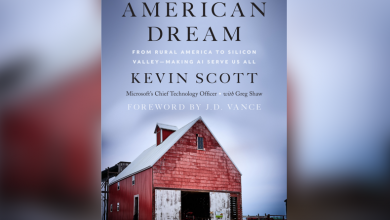Inside MoPOP’s world-premiere Marvel exhibit: The human sides of heroes and their creators
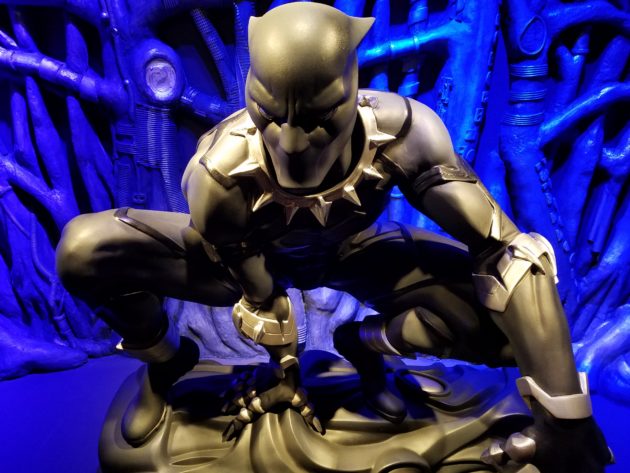
If you only know Marvel from the movies, you don’t really know Marvel.
That’s the sense you get when you enter the world-premiere exhibition at the Museum of Pop Culture in Seattle, “Marvel: Universe of Super Heroes.” The sprawling exhibit covers 10,000 square feet, sits on two floors, features 300 artifacts, and spans nearly 80 years of Marvel history.
Yet despite the celebrity of the past decade of blockbuster films, the exhibition itself begins outside a re-creation of a modest, 1940-era newsstand filled with what look like paper comic books.
“We just wanted to pay tribute to what was the first point of contact for the first generation of super hero comic book readers,” said exhibit chief curator Ben Saunders. “You had to buy your comics from some grumpy guy who didn’t care whether the latest books had shown up or not.”
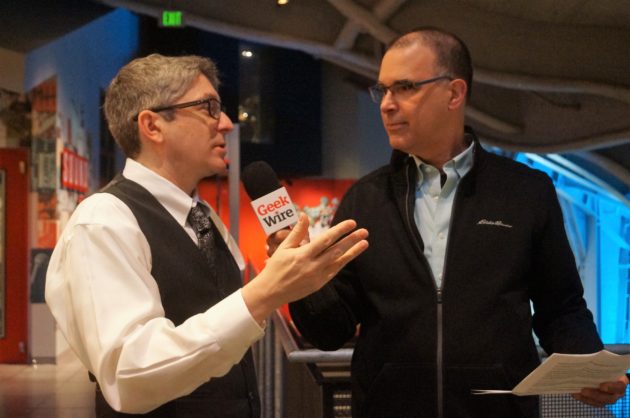
Saunders joined GeekWire for an episode of our special podcast series on popular culture, the arts, and science fiction. We talked about Marvel’s storied history dating back to 1939 as we walked through MoPOP’s representations of the newsstand, Tony Stark’s lab, Dr. Strange’s realm, and the gritty New York street where heroes like Daredevil, Jessica Jones, and Luke Cage hang out. (And yes, the recent movies, too, are well-represented with costumes, props, and more.)
Listen to the episode below or subscribe to the GeekWire Podcast to listen in your favorite podcast app.
Saunders, a professor of English at the University of Oregon and founding director of the undergraduate minor in Comics and Cartoon Studies, has organized three major comic art exhibitions and is the author of Do the Gods Wear Capes? But he says this exhibition has many artifacts that are on public display for the first time.
“No major institution for many years, for most of the 20th century, invested in comic book art particularly,” Saunders said. “So that means that nobody collected it, except for private collectors. You’re entirely dependent on the generosity of private individuals who own these objects, many of whom have never been asked to participate in an exhibition before.”
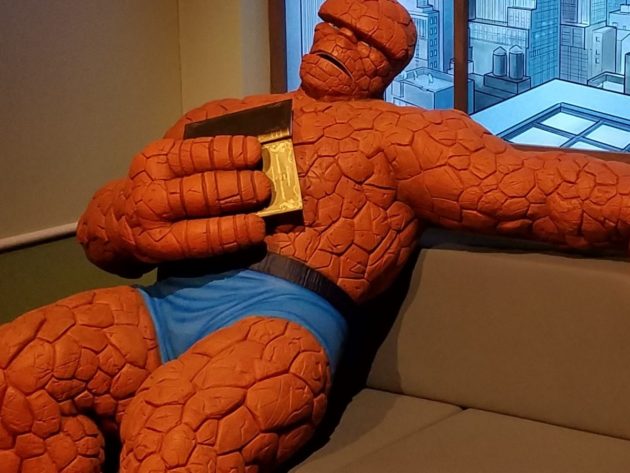
Saunders does have a personal exhibit favorite. It’s not so much an individual artifact as part of the exhibit itself: a life-size statue of Ben Grimm, The Thing, sitting on a couch in front of an animated picture window of Marvel’s New York City. The Fantastic Four team member is snoozing with a book in his hand. That book also represents an exhibition Easter egg.
“The Thing has fallen asleep on the couch here reading a weighty existential text called, The Thing in Itself,” Saunders said. “It’s written by Professor Stanley Kurtzberg, which for the hardcore fan, they will recognize that’s a marriage of the names of Stanley Lieber (Marvel’s Stan Lee) and Jacob Kurtzberg, (artist and writer) Jack Kirby’s birth name.”

Kirby and the creators of the comics are highlighted throughout the Marvel exhibit, in part because so often they are overshadowed by their better-known super hero creations. In addition to Kirby, who was as much of a creative force at Marvel as Stan Lee, there are panels of original art and covers by many others including Steve Ditko (Spider-Man), Jim Steranko (Nick Fury, Agent of SHIELD), and Bill Everett (Sub-Mariner). Everett, who was 19 at the time, is represented by what Saunders said is the only surviving page of original art from Marvel Comics No. 1.
“I actually am always surprised by how small it is, and I cannot believe the condition it’s in,” Saunders observed, noting the glue on the page hasn’t yellowed in nearly eight decades.
But Kirby was, in a word, special. “No Jack, no Marvel,” Saunders said flatly. “For a lot of people, Marvel is the house that Jack built.”
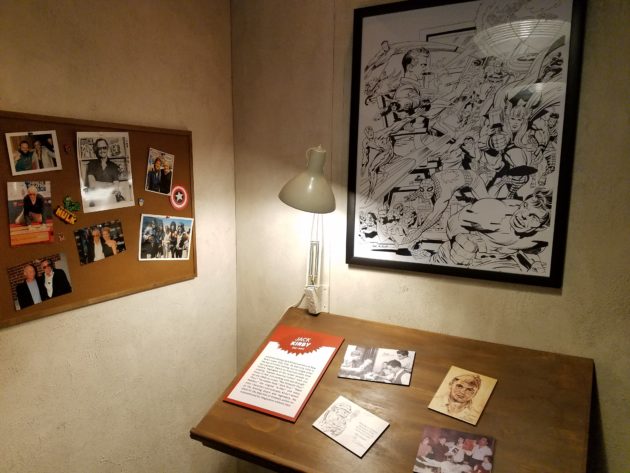
While Stan Lee is now better known with his continued media presence and cameos in Marvel films, Kirby was an “extraordinary collaborator.” Saunders said Kirby co-created Captain America, The Incredible Hulk, the original X-Men, Marvel’s Thor, and did the first concept sketches for Iron Man. “These are all from Kirby’s pen,” Saunders said. “Jack co-created all of those marquee characters that we are now familiar with, with the exception of Spider-Man, which was created by Steve Ditko.”
It was also these creators who, in the 1960s, came up with the distinctive Marvel formula: super heroes aren’t perfect.
“It’s that combination of human failing and yet ironic wit and humor that has successfully translated to the cinematic brand,” Saunders said, “that essential core of the idea that power doesn’t necessarily solve all your problems, and that you can wink at the audience a little bit at the same and have some sort of ironic fun. Those elements have translated brilliantly into the cinematic universe.”
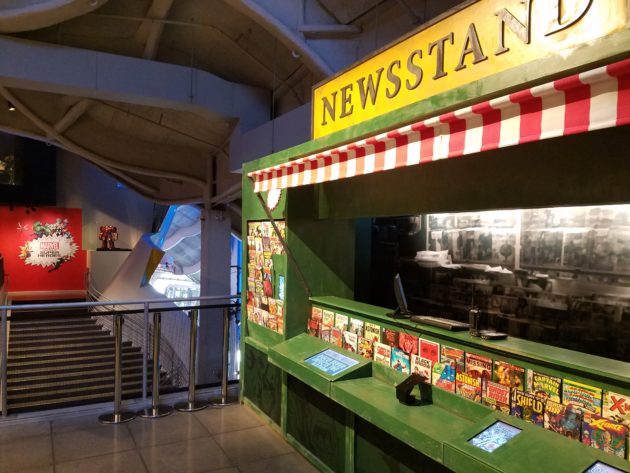
Perhaps because its characters were as much human as super, Marvel was not afraid to tackle tough societal issues in the comic books, from Tony Stark battling alcoholism to Black Panther fighting white supremacists. Stepping into the exhibition’s X-Men gallery prompted Saunders to provide even more examples.
“The X-Men became a comic in which Marvel’s writers and artists could explore themes of intolerance, racism, (and) homophobia, especially at a time in the late seventies and early eighties when comics were still seen in a lot of people’s minds as essentially a children’s medium,” Saunders said. “This was quite a powerful metaphor for exploring the pain of intolerance.”
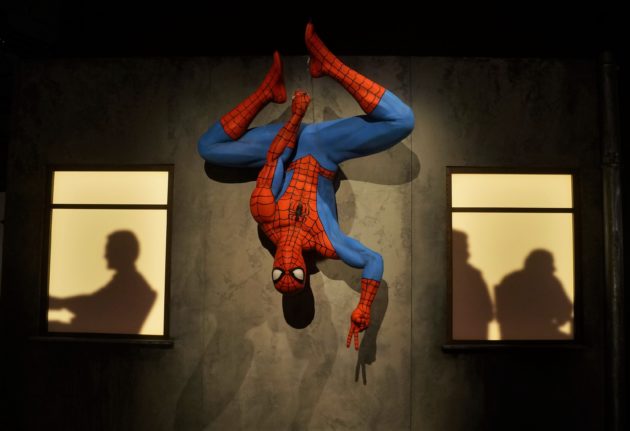
That very human Marvel vision displayed throughout the MoPOP exhibition also has inspired real-world individuals, including a younger Saunders living in the United Kingdom. As we stood inside a representation of Daredevil’s Hell’s Kitchen near the end of our exhibition walk, Saunders reflected.
“I moved to this country in part because of the fascination with a version of America that I read in the comics,” he said. “I think it would be wonderful if the culture could live up to the aspirations of some of its best fantasies, and if people at all levels thought that with great power comes great responsibility.”
Listen to this episode in the player above and subscribe to the GeekWire Podcast in Apple Podcasts, Google Play or your favorite podcast app. Podcast production and editing by Clare McGrane.
Previously in this series: Library of Congress saves the Pacific Northwest Tree Octopus and other online ‘web cultures’
Conclusion: So above is the Inside MoPOP’s world-premiere Marvel exhibit: The human sides of heroes and their creators article. Hopefully with this article you can help you in life, always follow and read our good articles on the website: Ngoinhanho101.com

